Patient education
Definition
Coronavirus disease 2019 (COVID-19) is a viral respiratory illness that causes fever, coughing, and shortness of breath, but many other symptoms can occur. COVID-19 is caused by a highly infectious virus, and it has spread throughout the world. Most people get mild to moderate illness. Older adults and people with certain health conditions are at high risk for severe illness and death.
Alternative Names
Coronavirus - 2019; Coronavirus - novel 2019; 2019 Novel coronavirus; SARS-CoV-2
Causes
COVID-19 is caused by the SARS-CoV-2 virus (severe acute respiratory syndrome coronavirus 2). Coronaviruses are a family of viruses that can affect people and animals. They can cause mild to moderate respiratory illnesses, such as the common cold. Some coronaviruses can cause severe illness that can lead to pneumonia and even death.
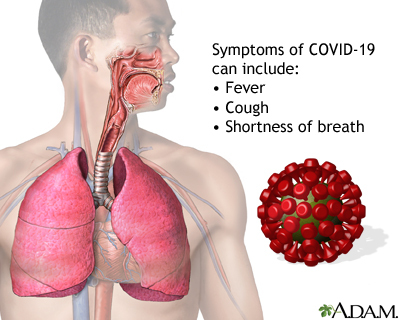
COVID-19 most readily spreads to people within close contact (about 6 feet or 2 meters). When someone with the illness coughs, sneezes, sings, talks, or breathes, droplets and very small particles spray into the air. You can catch the illness if you breathe in these droplets or particles or they get in your eyes.
In some instances, COVID-19 may spread through the air and infect people who are more than 6 feet away. Small droplets and particles can remain in the air for minutes to hours. This is called airborne (or aerosol) transmission, and it occurs especially in enclosed spaces with poor ventilation. However, it is more common for COVID-19 to spread through close contact.
Less often, the illness can spread if you touch a surface with the virus on it, and then touch your eyes, nose, mouth, or face. But this is thought to be a much less common way in which the virus spreads.
COVID-19 can spread from person to person quickly. As the virus spreads, it can change, and new variants will occur. Taking steps to slow the spread of the virus, such as by getting a COVID-19 vaccine, can help slow the development of new variants.
The United States Centers for Disease Control and Prevention (CDC) and the World Health Organization (WHO) consider COVID-19 a serious public health threat globally and in the United States. The situation continues to evolve, and local rates of infection vary significantly, so it's important to follow current local guidance on how to protect yourself and others from getting and spreading COVID-19.
Symptoms
COVID-19 symptoms range from mild to severe. Older people and people with certain existing health conditions have a higher risk of developing severe illness and death. Health conditions that increase this risk include:
- Asthma (if it's moderate or severe)
- Cancer
- COPD (chronic obstructive pulmonary disease)
- Cystic fibrosis
- Dementia
- Diabetes (type 1 and type 2)
- Down syndrome or other disabilities
- Heart disease and stroke
- HIV
- Kidney, lung, or liver disease
- Mental health conditions
- Overweight and obesity (BMI of 25 kg per square meter or above)
- Physical inactivity
- Pregnancy
- Organ or stem cell transplantation
- Sickle cell disease or thalassemia
- Smoking (current or former)
- Substance use disorders
- Tuberculosis
- Weak immune system (immunocompromised)
Symptoms of COVID-19 may include:
- Fever
- Chills
- Cough
- Shortness of breath or difficulty breathing
- Fatigue
- Muscle aches
- Headache
- Loss of sense of taste or smell
- Sore throat
- Stuffy or runny nose
- Nausea or vomiting
- Diarrhea
This is not a complete list of possible symptoms. Symptoms may change with new variants of the virus.
Some people may have no symptoms at all. Many people have some, but not all of the symptoms. Symptoms can also vary, depending on whether you are vaccinated and boosted.
Symptoms may appear within 2 to 14 days after being exposed. Most often, symptoms appear around 5 days after exposure. However, you can spread the virus even when you do not have symptoms.
More severe symptoms that require seeking medical help right away include:
- Trouble breathing
- Chest pain or pressure that persists
- Confusion or inability to wake up
- Blue lips or face
- Any other symptoms that are severe or that concern you
Exams and Tests
If you have symptoms of COVID-19, you can perform a self-test. Your health care provider also may decide to test you for the disease.
If you get tested for COVID-19, swabs from the back of the nose, the front of the nose, or the throat will be collected. If a person is thought to have COVID-19, these samples will be tested for SARS-CoV-2.
Treatment
If you are recovering at home, supportive care is given to help relieve symptoms. People with severe illness will be treated in the hospital. Some people are being given experimental medicines.
The types of medicines given may vary depending upon how sick you are, your risk factors for serious illness from the disease, your age, and possibly what variant of the virus is causing the infection.
If you test positive for COVID-19, your provider may recommend antiviral drugs.
If given soon after you become infected (5 to 7 days, depending on the drug), these medicines help your immune system fight off the virus. They may be given to adults and children with mild to moderate illness who are not hospitalized. These medicines include:
- Nirmatrelvir with ritonavir (Paxlovid), an antiviral medicine, to help slow the virus. It is a pill you take at home.
- Remdesivir, an antiviral medicine, to help slow the virus. This medicine is given through the vein (IV). You will need to go to a health care facility for 3 days in a row to receive this medicine.
- Molnupiravir (Lagevrio), an antiviral medicine used only for adults. It is a pill you take at home.
If you are being cared for in the hospital and are receiving oxygen therapy, treatment for COVID-19 may include the following medicines:
- Remdesivir, an antiviral medicine, to help slow the virus.
- Dexamethasone, a steroid medicine, to help reduce an overactive immune response in the body. If dexamethasone is not available, you may be given another corticosteroid such as prednisone, methylprednisolone, or hydrocortisone.
- You may be given one or the other medicine or both medicines together.
- Depending on your condition, you may also receive baricitinib or tocilizumab to help reduce immune system activity.
- You will be treated for any complications from the disease. For example, you may be given blood thinners to help reduce the chance of blood clots, or you may have dialysis if your kidneys do not function properly.
Based on available evidence, current treatment guidelines from the National Institutes of Health recommend against using some drugs for COVID-19, including chloroquine, hydroxychloroquine, and ivermectin. Do not take any drugs to treat COVID-19 except those prescribed by your provider. Check with your provider before treating yourself or a loved one with vitamins, nutrients, or any medicines prescribed in the past for other health problems. Since some COVID-19 medicines have interactions with other medicines or supplements you may be taking, always check with your provider before starting them.
Treatments for COVID-19 continue to be evaluated and guidelines continue to evolve. For the latest information about treatment for COVID-19, please see Coronavirus disease 2019 (COVID-19) treatment guidelines from the National Institutes of Health.
Possible Complications
Complications can include:
- Lasting COVID-19 symptoms that continue weeks or months after infection with the virus (called long COVID-19 or post-acute sequelae of SARS CoV-2 infection [PASC])
- Damage to the heart and blood vessels, kidneys, brain, skin, eyes, and gastrointestinal organs
- Respiratory failure
- Death
When to Contact a Medical Professional
You should contact your provider:
- If you have symptoms and think you may have been exposed to COVID-19
- If you have COVID-19 and you are in a group for whom antiviral medicine may be given
- If you have COVID-19 and your symptoms are getting worse
Call 911 or the local emergency number if you have:
- Trouble breathing
- Chest pain or pressure
- Confusion or inability to wake up
- Blue lips or face
- Any other symptoms that are severe or concern you
Before you go to a doctor's office or hospital emergency department (ED), call ahead and tell them that you have or think you may have COVID-19. Tell them about any underlying conditions you might have, such as heart disease, diabetes, or lung disease and any medicines you might be taking, including over-the-counter medicines, vitamins, or nutritional supplements. Wear the most protective mask you can that fits well without gaps and that you will wear, unless it makes it too hard to breathe. This will help protect other people you come in contact with.
Prevention
COVID-19 vaccines are used to boost the body's immune system and protect against COVID-19. These vaccines are the best tools to help stop the COVID-19 pandemic. Adults and children ages 6 months and older can get the COVID-19 vaccine to protect themselves from the virus.
To find out where to get a vaccine in your area, check with your local public health department. You can also use the CDC VaccineFinder.
Once you are fully vaccinated, take these steps to continue to protect you and the people around you:
- In most cases, you do not need to wear a mask when you are outdoors.
- You should wear a mask if you are in a crowded outdoor setting with people who may be unvaccinated.
- To reduce the risk of being infected with one of the COVID-19 variants and possibly spreading it to others, wear a mask indoors in public if you are in an area of high transmission.
You might choose to wear a mask regardless of the level of transmission if:
- You have a weakened immune system
- You are at increased risk for severe disease because of your age or an underlying medical condition
- A member of your household has a weakened immune system, is at increased risk for severe disease, or is unvaccinated
If you have COVID-19 or have symptoms of it, you must isolate yourself at home and avoid contact with other people, both inside and outside your home, to avoid spreading the illness. This is called home isolation. You should do this immediately and not wait for any COVID-19 testing.
- As much as possible, stay in a specific room and away from others in your home. Use a separate bathroom if you can. Do not leave your home except to get medical care. Wash your hands often.
- Do not travel while sick. Do not use public transportation or taxis.
- Keep track of your symptoms. You may receive instructions on how to check and report your symptoms.
- Stay in touch with your doctor. Before you go to a doctor's office or emergency department (ED), call ahead and tell them that you have or think you may have COVID-19.
- Use a well-fitted face mask or respirator that fits well over your nose and mouth without gaps when you see your health care provider and anytime other people are in the same room with you. If you can't wear a mask, for example, due to breathing problems, people in your home should wear a mask if they need to be in the same room with you.
- Avoid contact with pets or other animals. (SARS-CoV-2 can spread from people to animals, but it is not known how often this happens.)
- Cover your mouth and nose with a tissue or your sleeve (not your hands) when coughing or sneezing. Droplets that are released when a person sneezes or coughs are infectious. Throw away the tissue after use.
- Wash your hands many times a day with soap and running water for at least 20 seconds. Do this before eating or preparing food, after using the toilet, and after coughing, sneezing, or blowing your nose. Use an alcohol-based hand sanitizer (at least 60% alcohol) if soap and water are not available.
- Avoid touching your face, eyes, nose, and mouth with unwashed hands.
- Do not share personal items such as cups, eating utensils, towels, or bedding. Wash anything you have used in soap and water.
- Clean all "high-touch" areas in the home, such as doorknobs, bathroom and kitchen fixtures, toilets, phones, tablets, counters, and other surfaces. Use a household cleaning spray and follow instructions for use.
- Take steps to improve ventilation in your home. You can do this by turning on exhaust fans in your bathrooms and kitchen, using a portable air cleaner, and setting the fan on your furnace or air conditioning to “on” if you have central heating and cooling in your home.
You should remain at home, avoid contact with people, and follow the guidance of your provider and local health department about when to stop home isolation. Follow the advice of your provider and local health department regarding when you may return to work or other activities.
It's also important to help prevent the spread of the disease to protect people at high risk of serious illness and to protect providers who are at the front lines of dealing with COVID-19.
To find out what it happening in your community, check your local or state government website.
Learn more about COVID-19 and you:
For the latest research information:
Information about COVID-19 from the World Health Organization:
Gallery

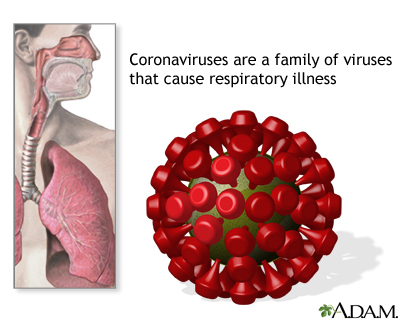

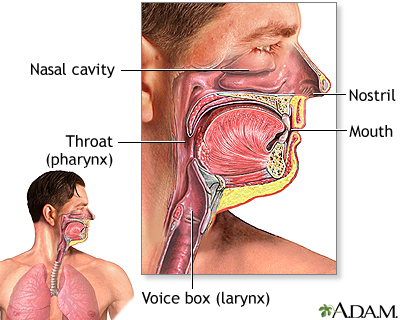
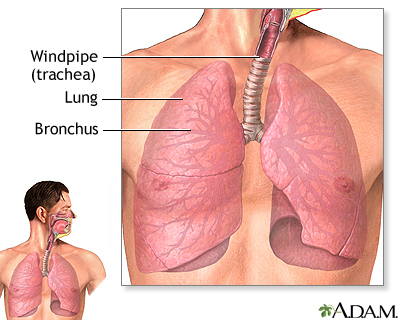
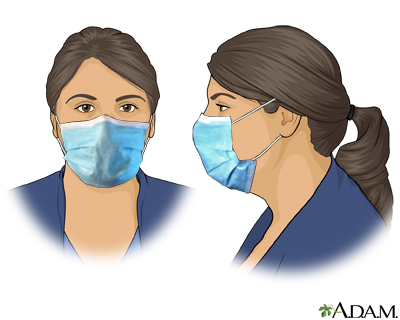
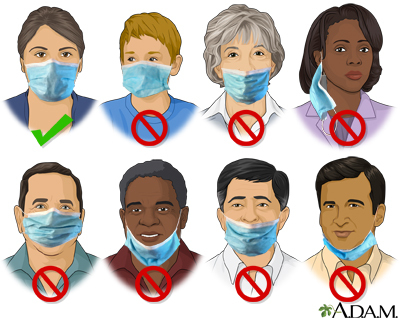
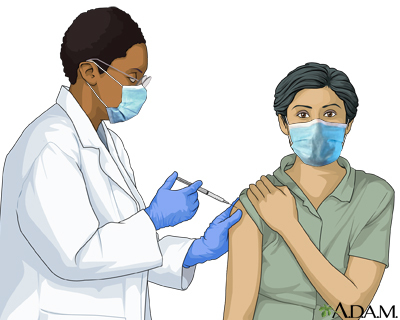
References
Centers for Disease Control and Prevention website. Stay up to date with COVID-19 vaccines including boosters. www.cdc.gov/coronavirus/2019-ncov/vaccines/stay-up-to-date.html#children. Updated January 25, 2023. Accessed January 27, 2023.
Centers for Disease Control and Prevention website. COVID-19: Frequently asked questions about COVID-19 vaccination. www.cdc.gov/coronavirus/2019-ncov/vaccines/faq.html. Updated February 15, 2023. Accessed January 23, 2023.
Centers for Disease Control and Prevention website. Long COVID or Post-COVID conditions. www.cdc.gov/coronavirus/2019-ncov/long-term-effects/index.html. Updated December 16, 2022. Accessed January 23, 2023.
Centers for Disease Control and Prevention website. COVID-19: COVID-19 treatments and medications. www.cdc.gov/coronavirus/2019-ncov/your-health/treatments-for-severe-illness.html. Updated February 10, 2023. Accessed January 23, 2023.
Centers for Disease Control and Prevention website. COVID-19: What to do if you are sick. www.cdc.gov/coronavirus/2019-ncov/if-you-are-sick/index.html. Updated February 6, 2023. Accessed January 27, 2023.
Centers for Disease Control and Prevention website. Variants of the Virus. www.cdc.gov/coronavirus/2019-ncov/variants/about-variants.html. Updated April 26, 2022. Accessed January 23, 2023.
National Institutes of Health. COVID-19 treatment guidelines. Clinical management of adults summary. www.covid19treatmentguidelines.nih.gov/management/clinical-management-of-adults/clinical-management-of-adults-summary/. Updated December 28, 2022. Accessed January 23, 2023.